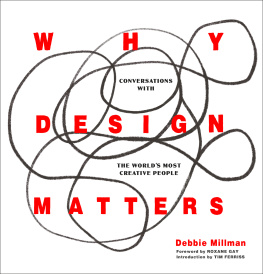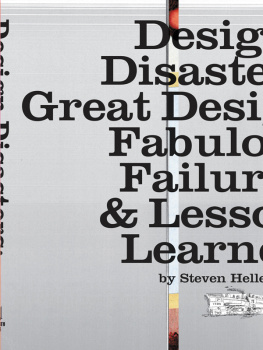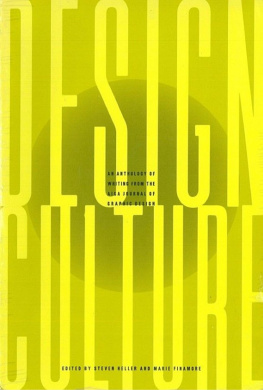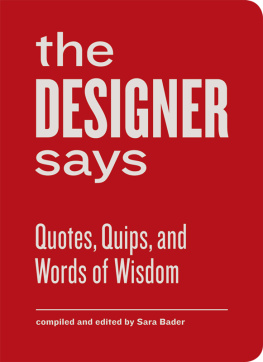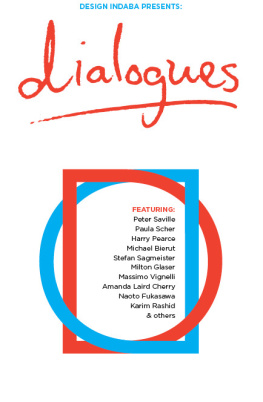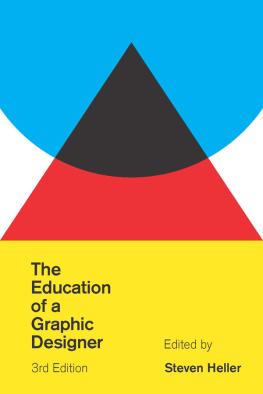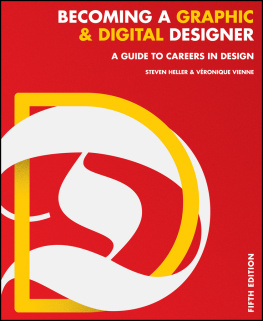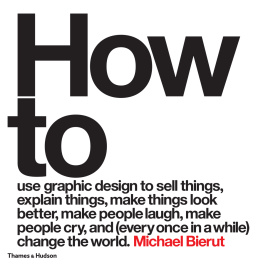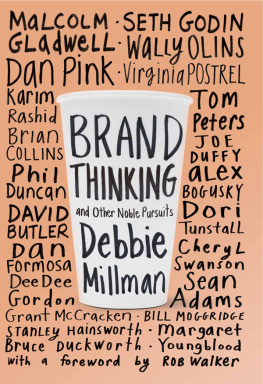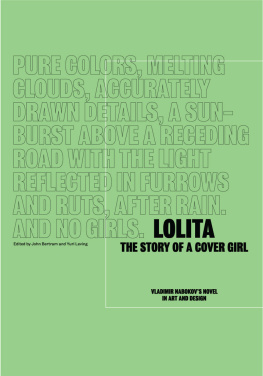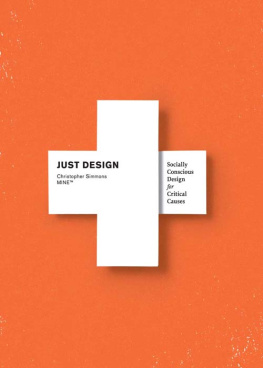HOW
TO THINK
LIKE A GREAT
GRAPHIC
DESIGNER
DEBBIE MILLMAN
with a foreword by steven heller

2007 DEBBIE MILLMAN
ALL RIGHTS RESERVED. COPYRIGHT UNDER BERNE COPYRIGHT CONVENTION, UNIVERSAL COPYRIGHT CONVENTION, AND PAN-AMERICAN COPYRIGHT CONVENTION. NO PART OF THIS BOOK MAY BE REPRODUCED, STORED IN A RETRIEVAL SYSTEM, OR TRANSMITTED IN ANY FORM, OR BY ANY MEANS, ELECTRONIC, MECHANICAL, PHOTOCOPYING, RECORDING, OR OTHERWISE, WITHOUT PRIOR PERMISSION OF THE PUBLISHER.
11 10 09 08 07 5 4 3 2 1
PUBLISHED BY ALLWORTH PRESS
AN IMPRINT OF ALLWORTH COMMUNICATIONS, INC.
10 EAST 23RD STREET, NEW YORK, NEW YORK 10010
COVER DESIGN BY RODRIGO CORRAL
INTERIOR DESIGN BY RODRIGO CORRAL DESIGN
EDITED BY JEREMY LEHRER
AUTHOR PHOTOGRAPH BY MARYANNERUSSELL.COM
LIBRARY OF CONGRESS CATALOGING-IN-PUBLICATION DATA
MILLMAN, DEBBIE.
HOW TO THINK LIKE A GREAT GRAPHIC DESIGNER/DEBBIE MILLMAN.
P. CM.
INCLUDES INDEX.
ISBN-13: 978-1-58115-496-2 (PBK.)
ISBN-10: 1-58115-496-8 (PBK.)
eBook ISBN: 978-1-58115-799-4
1. GRAPHIC ARTS. 2. GRAPHIC ARTISTSINTERVIEWS. I. TITLE.
NC1000.M55 2007
741.6DC22
2007029826
PRINTED IN THE UNITED STATES OF AMERICA
For a great man:
My father, Martin Millman
Foreword
by Steven Heller
It is not true that the interviewer is only as good as the interviewee. While a generous and articulate guest is key to any scintillating exchange, the interviewer cannot be passive, laconic, or, worse, uninformed. Interviews must be tackled with zeal, and the interviewer must control the discussion while waiting for that unexpected revelation to eke out. A skilled host must therefore prepare exhaustively: Take James Lipton of Inside the Actors Studio, with his famously large stack of blue index cards, each containing a pointed question neatly integrated into a systematic progression; while he theatrically examines the narratives of his subjects careers, he is always flexible enough to flow with unforeseen currents of conversation. Lipton builds on surprising admissions while keeping the interview on track. And this is no mean feat.
Interviewing requires considerable acumen to enable both the expressive and, especially, the reticent guest to open up. The worst-case scenario, the monosyllabic subject who resolutely guards each pearl of thought or emotion, can be avoided with a battery of insightful queries that forces a kind of challengein the good sense.
Debbie Millman, who has hosted the Internet radio program Design Matters since 2005, always does her homeworkand then some. With her dulcet intonations, she plies each of her visitors with questions designed to evoke the unexpected response. At the same time, she inspires their confidence, owing to her sincere interest in the life and work shes exploring. Her style is certainly not of the gotcha, Barbara Walters variety, yet neither does she wear kid gloves. Ive been interviewed by her on several occasions, and each time, her approach is somewhat different, tailored to the moment. Friendly yet challenging, she proceeds smoothly from the initial introductions to more free-form conversation. Debbie comes to the discussion well-prepared, not with cursory cheat sheets, but pages of incisive talking points garnered from extensive research.
Though she is the host of the only radio show devoted in large part to graphic design, Debbie was not trained as a journalist. The first time I saw her name was a few years ago on the then-fledgling design blog Speak Up, where she duked it out with founder Armin Vit about brands (which had become one of the forums btes noires). Debbies parries and thrusts with the critically skeptical Vit and his cohorts on the efficacy of branding made for a compelling debate, and her arguments were persuasive and eminently logical. But why shouldnt she be convincing? Debbie is a partner at Sterling Brands, a New Yorkbased brand identity firm, where her eloquence is well-utilized. Shes gracefully made it to the top of a male-dominated business, and her considerable strategic marketing savvy allows her to be an effective advocate of design.
In large part, this is because she is a devoted aficionado of design and designers, although her interests extend into realms of science and psychology (which she poetically examines in her own blog, http://debbiemillman.blogspot.com). Perhaps another reason she is so adept in conversation is that she truly enjoys learning from others. Her passionate concern for the practice and history of design makes her interviews captivating, though listening to designers talk about their craft could potentially be too arcane even for those in the field. Yet Debbie makes her program riveting by balancing, for instance, the real skinny on Michael Bieruts obsessive tendencies with insights about his design for Saks Fifth Avenues shopping bag.
I often paraphrase Paul Rands statement about how he intuitively came up with an idea and then found the rationale for it later, which isnt to say that comprehending the roots of a concept, or even learning about the technology behind it, is bad, but it takes oratory skill and an understanding of nuance to deconstruct a project so that the details are not banal. The virtue of interviews with designersas opposed to prose narratives about themis that they cut through the intellectualizing and get to the creative essence, whatever that might be.
While an interview is not inherently easy, the best enable the voicethe intelligence, humor, irony, even sarcasmof the designer to emerge. Debbie has, through her tte--ttes with the designers in this book, managed to extract the nitty-gritty of their practices without sacrificing their respective humanity. She allows them to speak, but never too muchor too little.
Introduction
by Debbie Millman
From: Steff Geissbuhler
Date: December 3, 2006 6:10:45 PM EST
To: Debbie Millman
Subject: Re: How To Think Like A Great Graphic Designer
Debbie,
I think that we talk to ourselves, about ourselves, way too much. We have conferences where we talk to ourselves, we give each other awards, we publish each others work and words, and basically we pat each other on our backs.
Im afraid that your book will be read by Graphic Designers only and therefore simply add to the incestuous writing in our profession. However, I found myself answering your questions to see how I would respond. I might be cringing when its published, but here it is.
I hope you dont mind my critical point of view.
I often get questions like this from students, and whenever I do, I get the sense that they are fishing for a recipe to become a successful designer.
With best regards,
Steff
Steff Geissbuhler, Partner
C&G Partners
Despite its title, this book will not provide the reader with a recipe to think like some of the most accomplished graphic designers of our time. Consider it instead a glimpse into the minds of these revered masters, in order to understand the way they think and why.
This book didnt start out quite this way. Initially, I set out to create an anthology that did, in fact, attempt to uncover common denominators and describe the thought processes of those venerated in the design field. Many of my original questions smacked of superficiality, and even though I was miffed when I first received Steff Geissbuhlers reply, I quickly came to my senses. After all, Steff had a point. Perhaps we do talk to ourselves, about ourselves, way too much. But given the fact that design is a fairly young field, is there anything inherently wrong with a robust internal dialogue?
Next page

